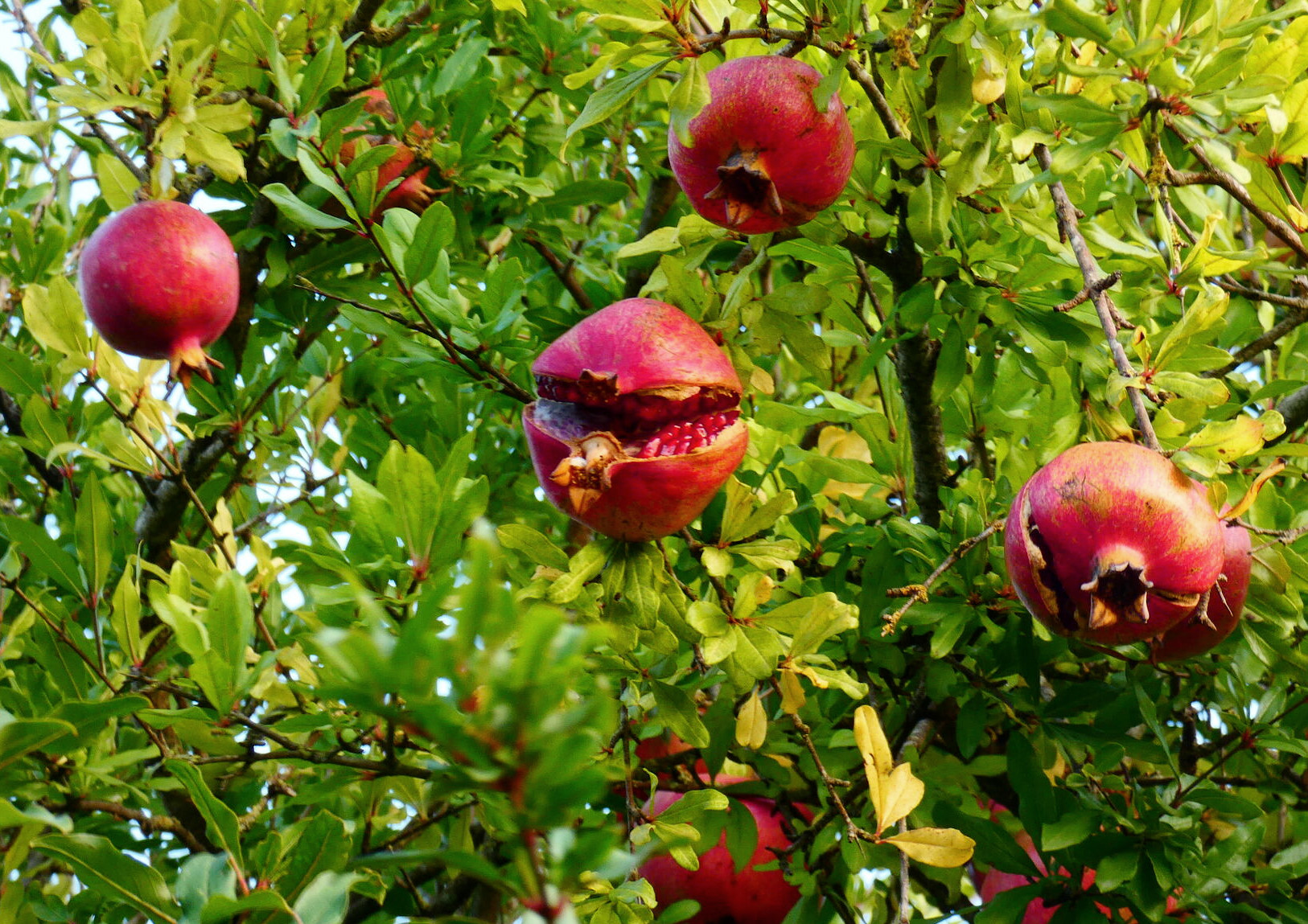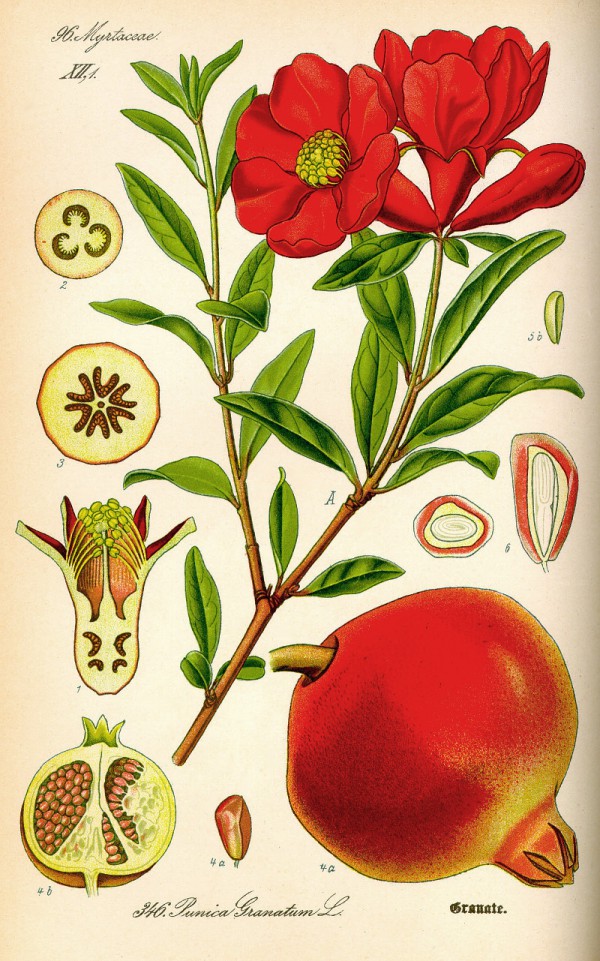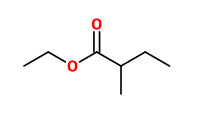Punica granatum L. - syn.Punica nana L. - Lythraceae. (also placed in Punicaceae) - pomegranate, Granatapfel
Deciduous shrub or small tree, native to central Asia, cultivated and naturalized elsewhere; leaves lanceolate to elliptic-oblong; flowers campanulate-urceolate, yellow to orange-red; fruit a leathery berry, globose, red or red-brown, 5-12cm in diameter; seeds obpyramidal within juicy sarcotestal layer, ruby-red. „Punica granatum is grown for its showy flowers and edible fruit (pomegranate).“
http://www.efloras.org/florataxon.aspx?flora_id=2&taxon_id=200014674
„The entire seed is consumed raw, though the watery, tasty sarcotesta is the desired part. The taste differs depending on the variety or cultivar of pomegranate and its ripeness… Pomegranate juice can be sweet or sour, but most fruits are moderate in taste, with sour notes from the acidic tannins contained in the juice.“ wikipedia
„One of the most important quality characteristics of the pomegranate is the red pigmentation of its seeds and juice. This red color depends on anthocyanin concentration and on the chemical structure of the individual anthocyanin. Delphinidin derivatives are responsible for blue and violet hues, while pelargonidin is related to red–orange colors. Previous studies have shown that six anthocyanins are found in the juice of pomegranates, namely delphinidin 3-glucoside and 3,5-diglucoside, cyanidin 3-glucoside and 3,5-diglucoside, and pelargonidin 3-glucoside and 3,5-diglucoside. The peel contains only the pelargonidin and cyanidin derivatives, and no delphinidin is detected… The highest anthocyanin content was that observed for clone VA1, (close to 160 mg anthocyanin per liter of juice), followed by those of the two Mollar clones (MA2, ME16), which contained more than 100 mg/l.“
[Evolution of juice anthocyanins during ripening of new selected pomegranate (Punica granatum) clones. Hernandez, F., Melgarejo, P., Tomas-Barberan, F.A., Artes, F., European Food Research and Technology, Vol.210(1), 1999, 39-42] PDF
„While juice from fresh squeezed arils was characterized by having high fruity-dark, floral, fruity and sweet overall notes, commercial juices had more cranberry, wine-like and grape notes. Fresh-squeezed juice was characterized by the presence of aldehydes and terpenes, while the commercial juices had a combination of compounds which included mainly alcohols and some esters and furans. No experiments were done to test the relationship between the identified compounds and the sensory attributes, but these tentative results seemed to show that aldehydes and terpenes contributed to the fruity, sweet overall and fruity dark notes of the fresh juice.“
[Instrumental and sensory aroma profile of pomegranate juices from the USA: differences between fresh and commercial juice., Vázquez‐Araújo, L., Koppel, K., Chambers IV, E., Adhikari, K., Carbonell‐Barrachina, A.A., Flavour and fragrance journal, Vol.26(2), 2011, 129-138]
„Twenty-one compounds were found in the headspace of fresh pomegranate juices, including aldehydes, monoterpenes, and alcohols. The most abundant compounds were hexanal, limonene, trans-2-hexenal, and cis-3-hexenol… Overall consumer liking of pomegranate juices was mainly associated with the presence of monoterpenes (α-terpineol); however, high aldehydes (trans-2-hexenal) concentrations were correlated with poor overall consumer liking.“
[Volatile composition of pomegranates from 9 Spanish cultivars using headspace solid phase microextraction., Melgarejo, P., Calín‐Sánchez, Á., Vázquez‐Araújo, L., Hernández, F., Martínez, J.J., Legua, P., Carbonell‐Barrachina, Á.A., Journal of food science, Vol.76(1), 2011, 114-120]
„A total of 18 compounds were found in pomegranate aroma profiles, including monoterpenes, aldehydes, alcohols, monoterpenoids and linear hydrocarbons. The most abundant compound were trans-2-hexenal, 3-carene, α-terpinene and α-terpineol. The total concentration of volatiles ranged from 1.7 to 10.9 g kg−1. Overall consumer liking of pomegranate juices was associated with the presence of monoterpenes such as α-pinene, β-pinene, β-myrcene, limonene and γ-terpinene. The presence of aldehydes such as hexanol, hexanal and cis-3-hexenol was correlated with poor overall consumer liking.“
[Volatile composition and sensory quality of Spanish pomegranates (Punica granatum L.)., Calín‐Sánchez, Á., Martínez, J.J., Vázquez‐Araújo, L., Burló, F., Melgarejo, P., Carbonell‐Barrachina, Á.A., Journal of the Science of Food and Agriculture, Vol.91(3), 2011, 586-592]
In HS-SPME and SAFE aroma extracts, 12 volatiles were found to possess aroma activity: Ethyl-2-methyl-butanoate (fruity, apple), hexanal (pine, herbal), myrcene (woody, musty), cis-3-hexenal
(green), β-pinene (green), limonene (fruity, musty), cis-2-heptenal (soapy, mushroom), cis-3-hexenol (earthy, grassy), 2-ethylhexanol (floral), β-caryophyllene (fruity, musty), 2(5H)-furanone (sweet, fruity) and β-sesquiphellandrene (terpene, almond).
„According to our GC–O analysis, the most prominent aroma-active compounds in ‘Wonderful’ pomegranates,
which were detected by at least five out of seven different panellists, were ethyl 2-methylbutanoate (fruity, apple), β-pinene (pine, herbal), cis-3-hexenal (green), cis-2-heptenal (soapy, mushroom) and β-caryophyllene (fruity, musty).“
[Mayuoni-kirshinbaum, Lina, et al. „Identification of aroma-active compounds in ‘wonderful’pomegranate fruit using solvent-assisted flavour evaporation and headspace solid-phase micro-extraction methods.“ European Food Research and Technology 235.2 (2012): 277-283]
„Gas chromatography–mass spectroscopy (GC-MS) analysis revealed the presence of 3-octen-1-yl acetate, trans-3-hexen-1-ol, hexanol and 2-methyl pentanol only in the high vacuum distillate. Ether extract was dominated by 2-heptanol, 2-nonanol and 3-methyl-2-butanol. Based on olfactometric analysis of the HVD isolate, 3-octen-1-yl acetate was identified as the key odorant of pomegranate. Chemical synthesis of this compound, further confirmed its structure. Among the bound aroma compounds, 2-phenylethanol (40%), alpha-terpineol (4.53%) and 2-heptanol (6.35%) were identified as the major compounds existing as glycoconjugates.“
[Tripathi, Jyoti, et al. „Analysis of free and bound aroma compounds of pomegranate (Punica granatum L.).“ LWT-Food Science and Technology 59.1 (2014): 461-466]
The GC-O-identified eleven aroma-active compounds which could characterize the overall aroma profiles of Dahongtian pomegranate juice were β-pinene, myrcene, limonene, hexanol, cis-3-hexenol, 1-octen-3-ol, heptanol, linalool, hexanal, nonanal, and naphthalene. „In particular, the models, lacking all terpenes, β-myrcene, all alcohols, (Z)-3-hexen-1-ol, linalool, and 1-hexanol, showed noticeable difference (P < 0.001 or P < 0.01). These findings suggest that these compounds are of great importance for the overall aroma…“
[Lu, Cong, et al. „Characterization of the key aroma compounds in four varieties of pomegranate juice by gas chromatography-mass spectrometry, gas chromatography-olfactometry, odor activity value, aroma recombination, and omission tests.“ Food Science and Human Wellness 12.1 (2023): 151-160]

Punica granatum, Barcelona, Spain (2025) © cris_mc CC BY-SA 4.0 inaturalist.org

Thomé, O.W., Flora von Deutschland Österreich und der Schweiz, Tafeln, vol.3, t.346 (1885)
http://plantgenera.org/species.php?id_species=854881



